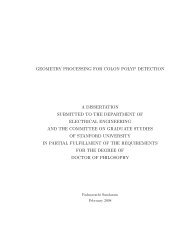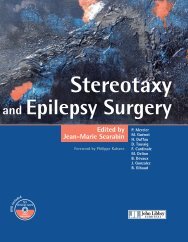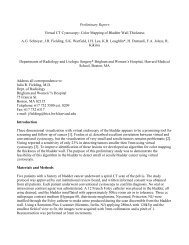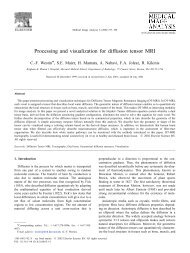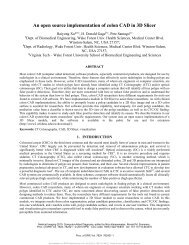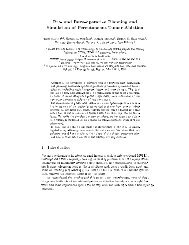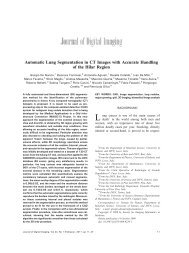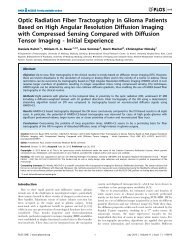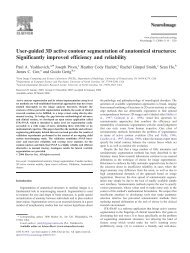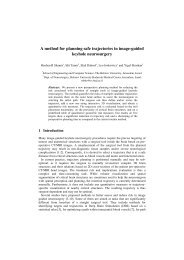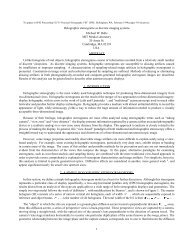BWH Manual (PDF) - INTRuST Neuroimaging Leadership Core
BWH Manual (PDF) - INTRuST Neuroimaging Leadership Core
BWH Manual (PDF) - INTRuST Neuroimaging Leadership Core
Create successful ePaper yourself
Turn your PDF publications into a flip-book with our unique Google optimized e-Paper software.
<strong>INTRuST</strong> Study Background and Significance<strong>Neuroimaging</strong> studies involving multiple sites are becoming more common as advances in imaginghardware and software are made. With multiple sites, studies are able to obtain more diverse andlarger patient populations, while studying smaller and smaller effects. The challenge to these studies,however, is obtaining data of similar quality from each site so that site effects do not overwhelm thedisease or drug effect. Typically, each site will have optimized a particular imaging protocol for theirspecific scanner hardware and software versions and processing pipeline. These ‘optimized’versions may have significantly different protocol parameters and resulting widely different signal- andcontrast-to-noise ratios (SNR, CNR). Therefore, the initial step of each multi-site trial must be toharmonize the imaging protocols across sites by comparing data acquired with varied protocolparameters and determining those parameters that result in identical SNR or CNR. Then, after ageneralized protocol is decided upon, data is acquired from a separate cohort of subjects as baselinedata to be compared against data acquired after scanner upgrades of either hardware or software. Inthis way, sites can monitor their data quality and ensure that it will be combinable with those fromother sites throughout the life of the study.While advanced neuroimaging methods used to be the province of a few specialized laboratories,today such techniques have become widespread and, indeed, are almost required for seriousinvestigation of many kinds of physiological and patho-physiological questions. However, the use ofdata from multiple sites raises the question of “How does data acquired at one site compare to datacollected at the other sites?” The real issue of interest here is the desire to ensure that data collectedfrom multiple sites is ‘equivalent’ and can, therefore, be subjected to the same processing pipeline.Differences in contrast can lead to nonequivalent processing. For example, if the gray-white mattercontrast is less at site A than at site B, the accuracy of the gray-white boundary determination may beless in site A’s data and therefore the processed data from sites A and B are not easily comparable.The neuroimaging technique used in the proposed study is magnetic resonance imaging (MRI), anon-invasive diagnostic imaging technique which allows investigators to “see inside” the body withoutsurgery or ionizing radiation (i.e. without x-rays). The MRI scanner uses only a magnetic field andradio waves to produce a picture of the human anatomy.Magnetic resonance imaging techniques are constantly being developed and optimized to increasethe speed of acquisition, improve image quality, and expand the information content of the resultingimages. Such developments are made possible by advances in the computer software running onthe scanner. Improved software options of the MR system call for evaluation to determine how theycan best be applied to research studies employing the equipment.MR software is often initially evaluated using inanimate test phantoms. Trials involving humansubjects are a necessary step in the development of new MR software since test phantoms are ofteninadequate for simulating real life conditions. For example, test phantoms cannot be used tovisualize subtle changes in tissue contrast or evaluate the effects of voluntary or involuntary patientmovement, breathing, or blood flow. Therefore, limited human subject testing is necessary toevaluate and optimize the performance of the MR hardware and software. This will entail adjustingthe MR pulse sequence properties and assessing specific image quality measures such as tissuecontrast, image artifact levels, and signal-to-noise ratio.The optimization work performed under this protocol will be based on and informed by neuroimagingcalibration and standardization work performed by the <strong>INTRuST</strong> <strong>Neuroimaging</strong> <strong>Leadership</strong> <strong>Core</strong>(NLC). The goal of these testbeds was to provide best practices and tools for the entire flow of dataarising from a multi-site trial; from protocol design to data storage and sharing. Members of the<strong>INTRuST</strong> NLC developed and optimized the imaging protocols used in this study. The final protocols,determined by the results of this study, will be used to collect data for the <strong>INTRuST</strong> consortium andthis data will be distributed amongst, and used by, members of the consortium.The broadly defined mission of the overall project is to address the needs of individuals at risk foradverse psychological, emotional, and cognitive outcomes resulting from a traumatic injury. Theconsortium will test new therapies that enhance recovery of at-risk individuals and for thoseindividuals who have already developed chronic neuropsychiatric problems. The program will alsofocus on the time course of symptoms caused by mild head injuries.



